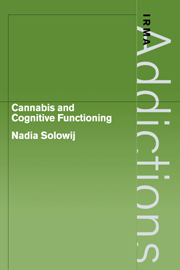Book contents
- Frontmatter
- Contents
- Series editor's preface
- Author's acknowledgements
- 1 Statement of the problem
- PART 1 A REVIEW OF THE LITERATURE
- PART 2 RESEARCH
- 7 An event-related potential study of attentional processes in long-term cannabis users
- 8 An investigation of the effects of frequency and duration of cannabis use
- 9 An investigation of the reversibility of cognitive impairment in ex-cannabis users
- 10 A single case study of cessation of cannabis use
- 11 Anxiety, psychopathology and the qualitative experience of long-term use of cannabis
- 12 Summary, synthesis and conclusions
- Appendix
- References
- Index
11 - Anxiety, psychopathology and the qualitative experience of long-term use of cannabis
from PART 2 - RESEARCH
Published online by Cambridge University Press: 16 September 2009
- Frontmatter
- Contents
- Series editor's preface
- Author's acknowledgements
- 1 Statement of the problem
- PART 1 A REVIEW OF THE LITERATURE
- PART 2 RESEARCH
- 7 An event-related potential study of attentional processes in long-term cannabis users
- 8 An investigation of the effects of frequency and duration of cannabis use
- 9 An investigation of the reversibility of cognitive impairment in ex-cannabis users
- 10 A single case study of cessation of cannabis use
- 11 Anxiety, psychopathology and the qualitative experience of long-term use of cannabis
- 12 Summary, synthesis and conclusions
- Appendix
- References
- Index
Summary
The cannabis users and ex-users studied in each experiment reported here completed a number of questionnaires. These assessed levels of anxiety, symptoms of psychopathology and dependence on cannabis and provided an opportunity for the self report of any problems associated with longterm cannabis use. A qualitative description of the experience of longterm cannabis use was obtained through structured and open-ended questionnaires.
The inclusion of these assessments was important for two reasons: (1) to exclude the possibility that the event-related potential (ERP) findings might reflect some psychological differences between users and nonusers rather than being the result of cannabis use, with anxiety and psychopathology judged to be the most likely candidates, and (2) to examine the consistency between self reported symptoms of dependence, subjective effects and cognitive failure and the results obtained from assessment of cognitive functioning by means of ERP measures of selective attention.
This chapter will present descriptive summaries of the results of all questionnaires administered, provide results of quantitative analyses where appropriate and discuss the qualitative experience of long-term cannabis use. The results from each sample from each experiment will be discussed separately but also combined across studies where appropriate. Correlations between test measures and the ERP results of each study will be presented where appropriate. The ERP measures used in correlational analysis were PN to pitch irrelevant tones measured over 300 to 600 ms at frontal and central sites, which reflects the unnecessary processing of complex irrelevant information, and P300 latency measured at the contralateral parietal scalp site, as a measure of stimulus evaluation time, or the speed of information processing. Wherever possible, the results were considered in terms of frequency and duration of cannabis use.
- Type
- Chapter
- Information
- Cannabis and Cognitive Functioning , pp. 207 - 226Publisher: Cambridge University PressPrint publication year: 1998

